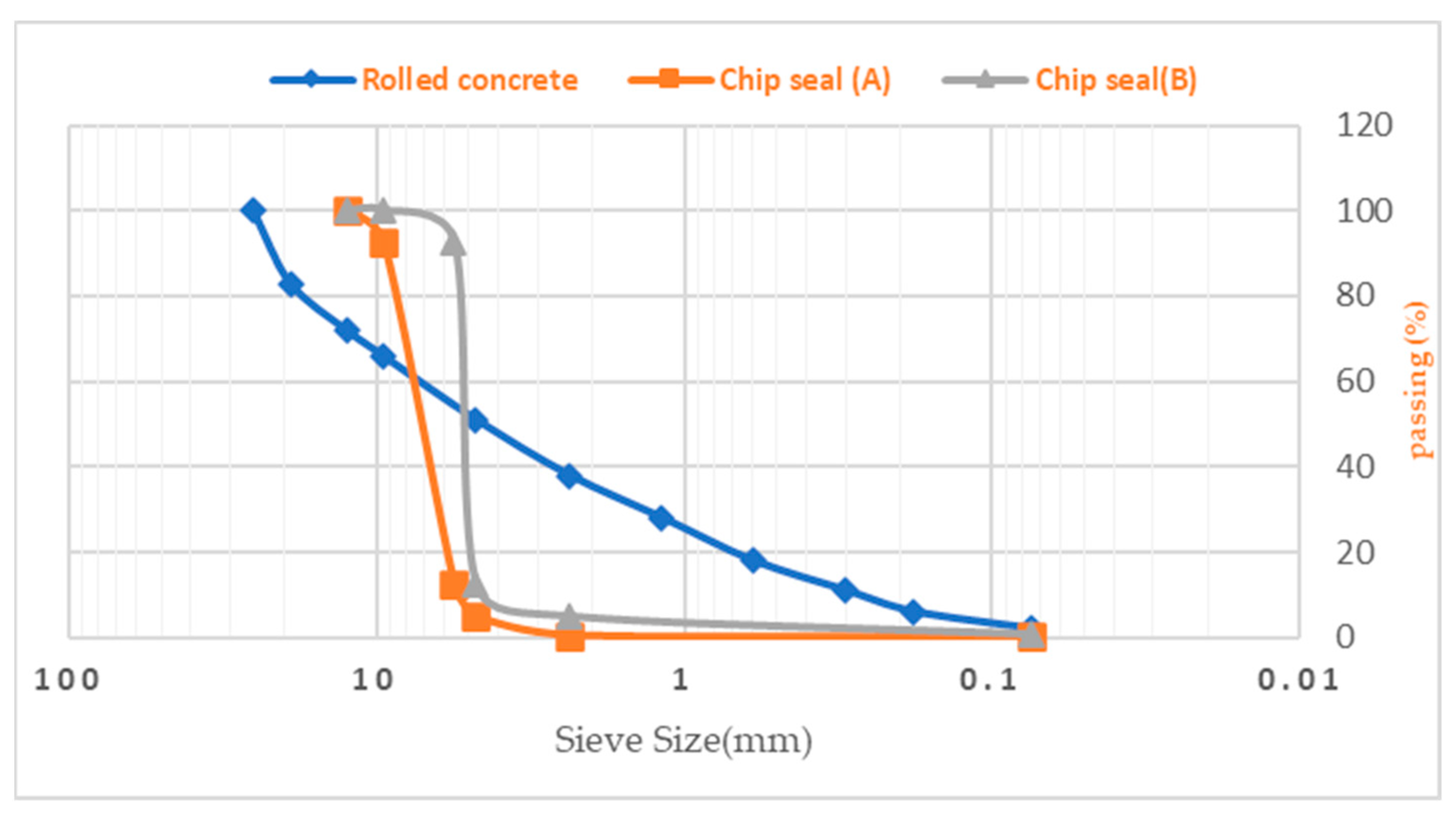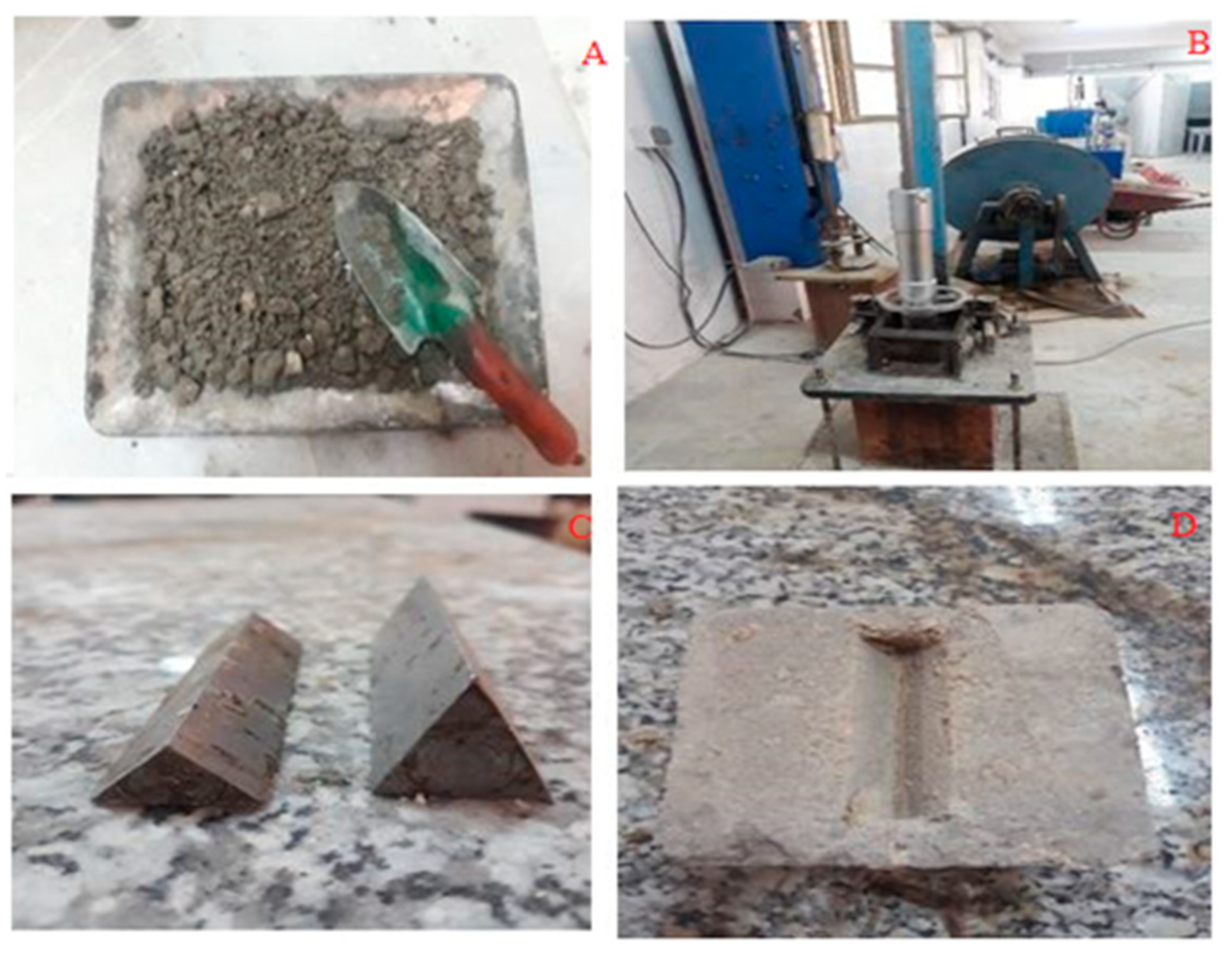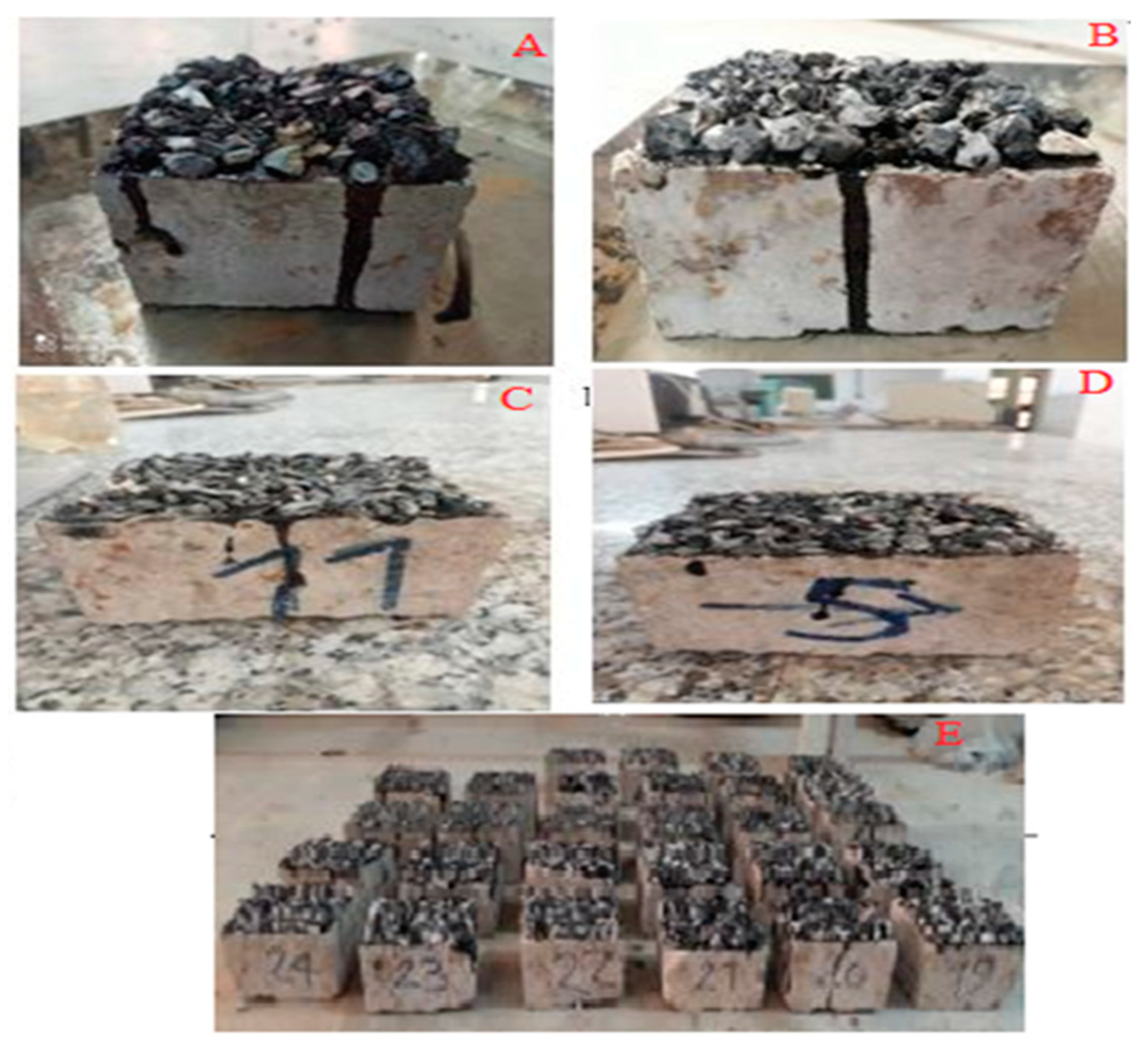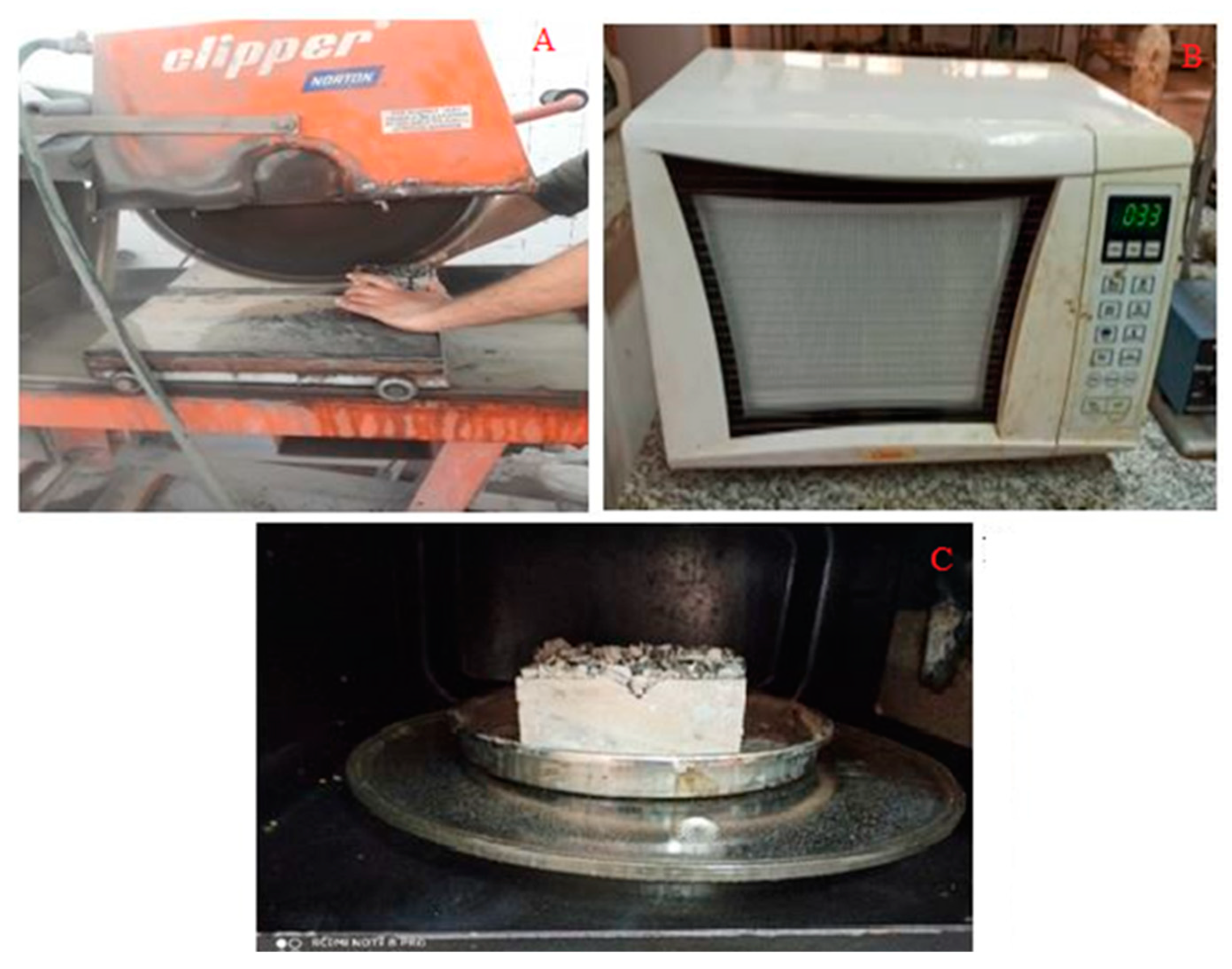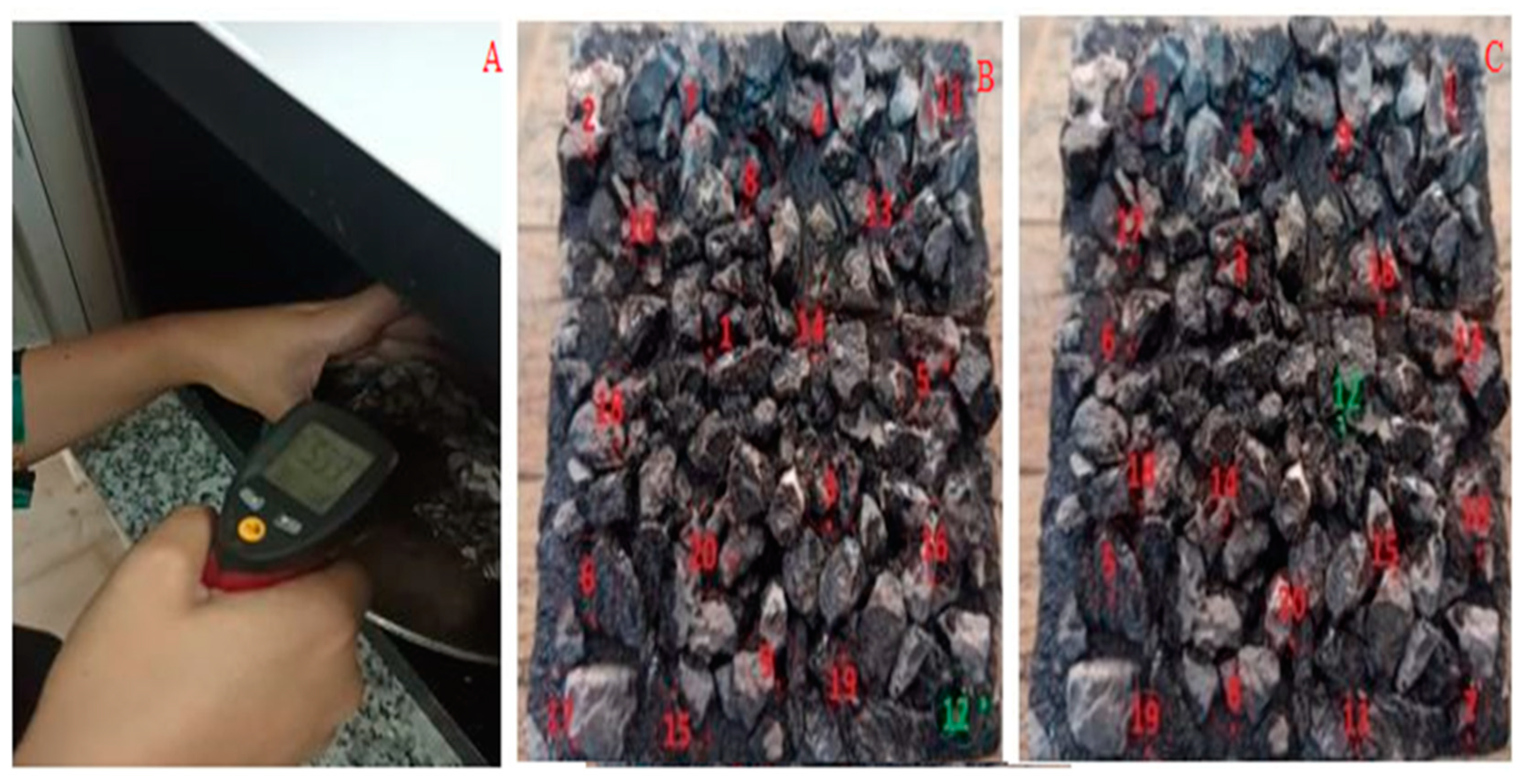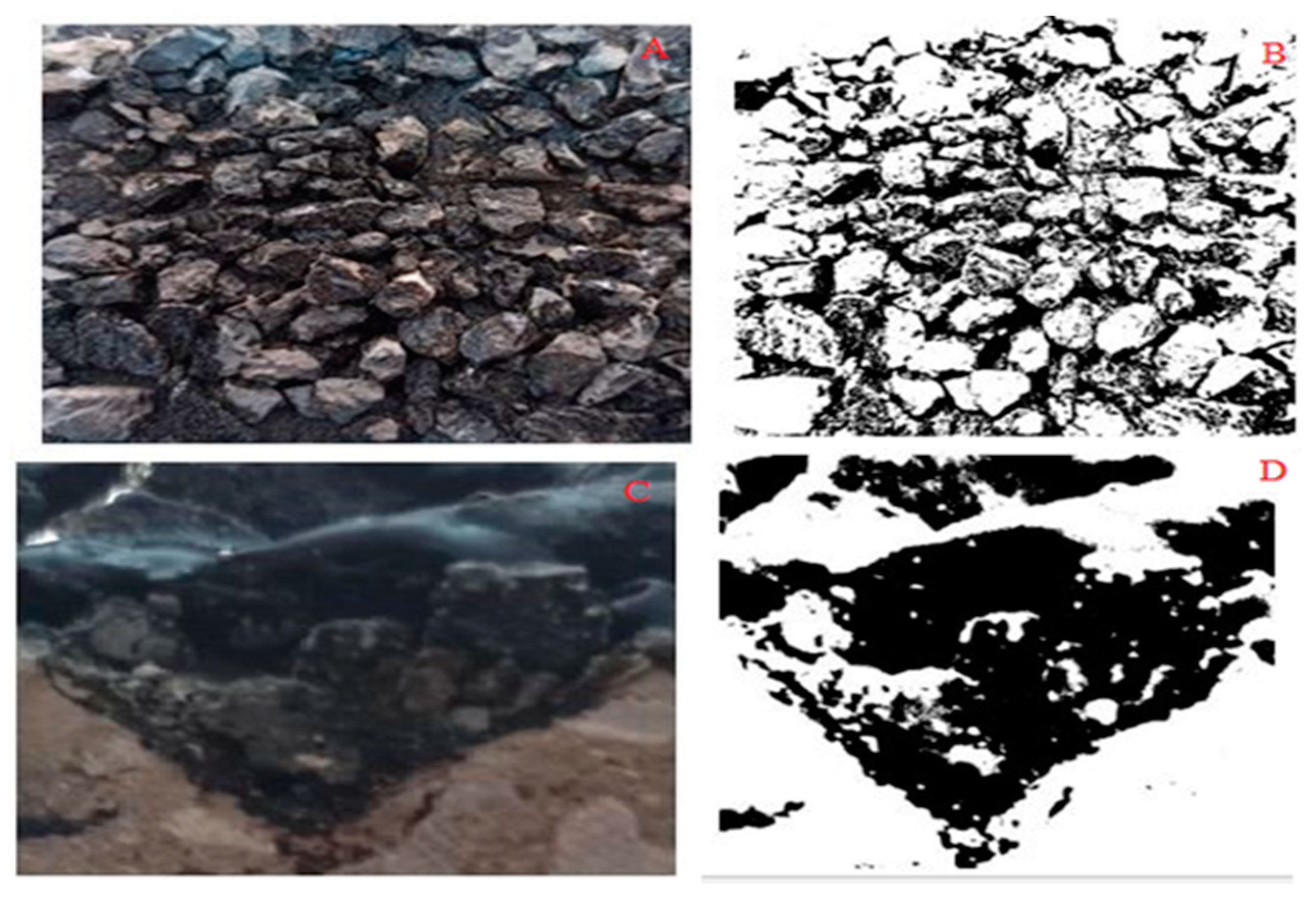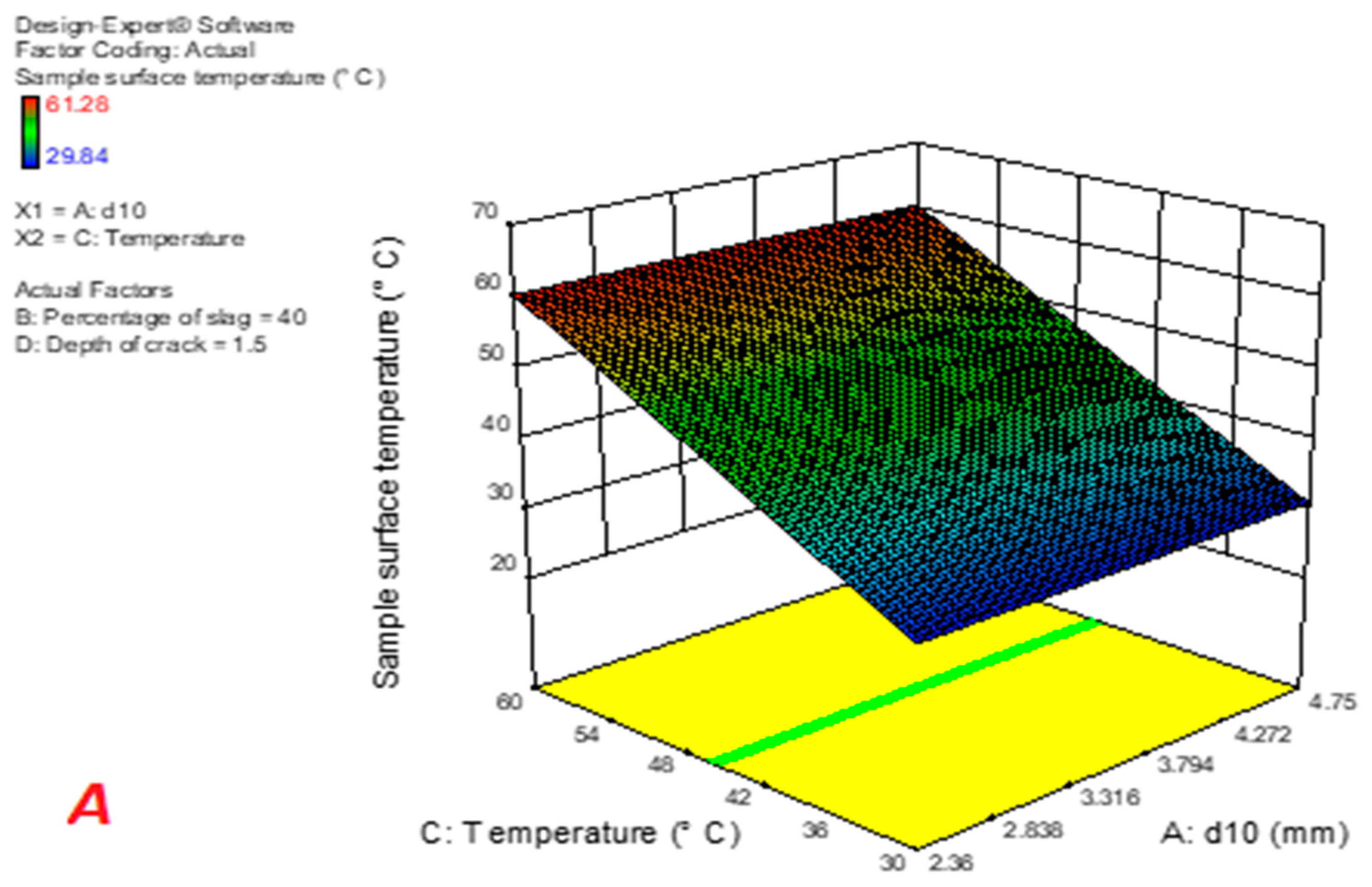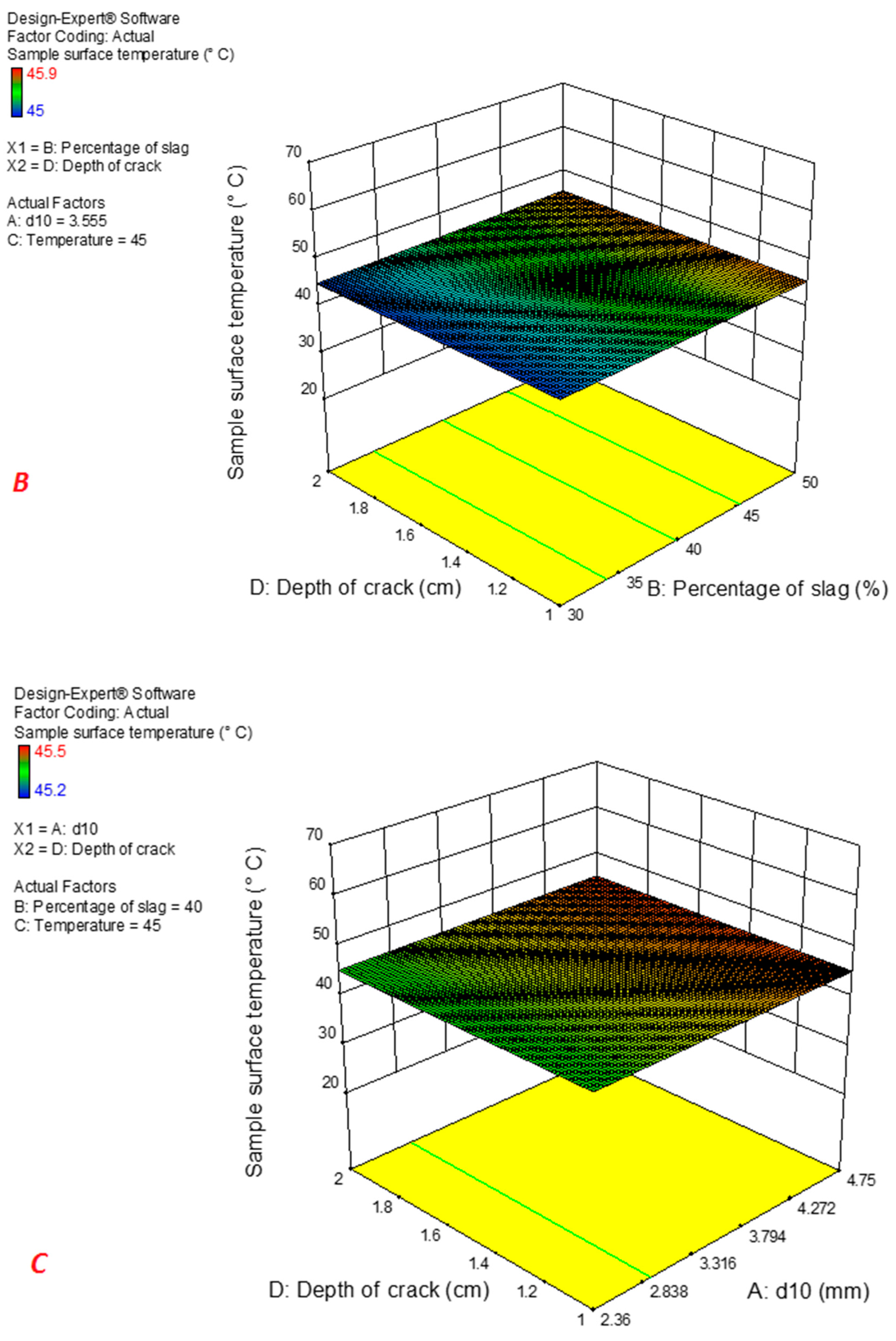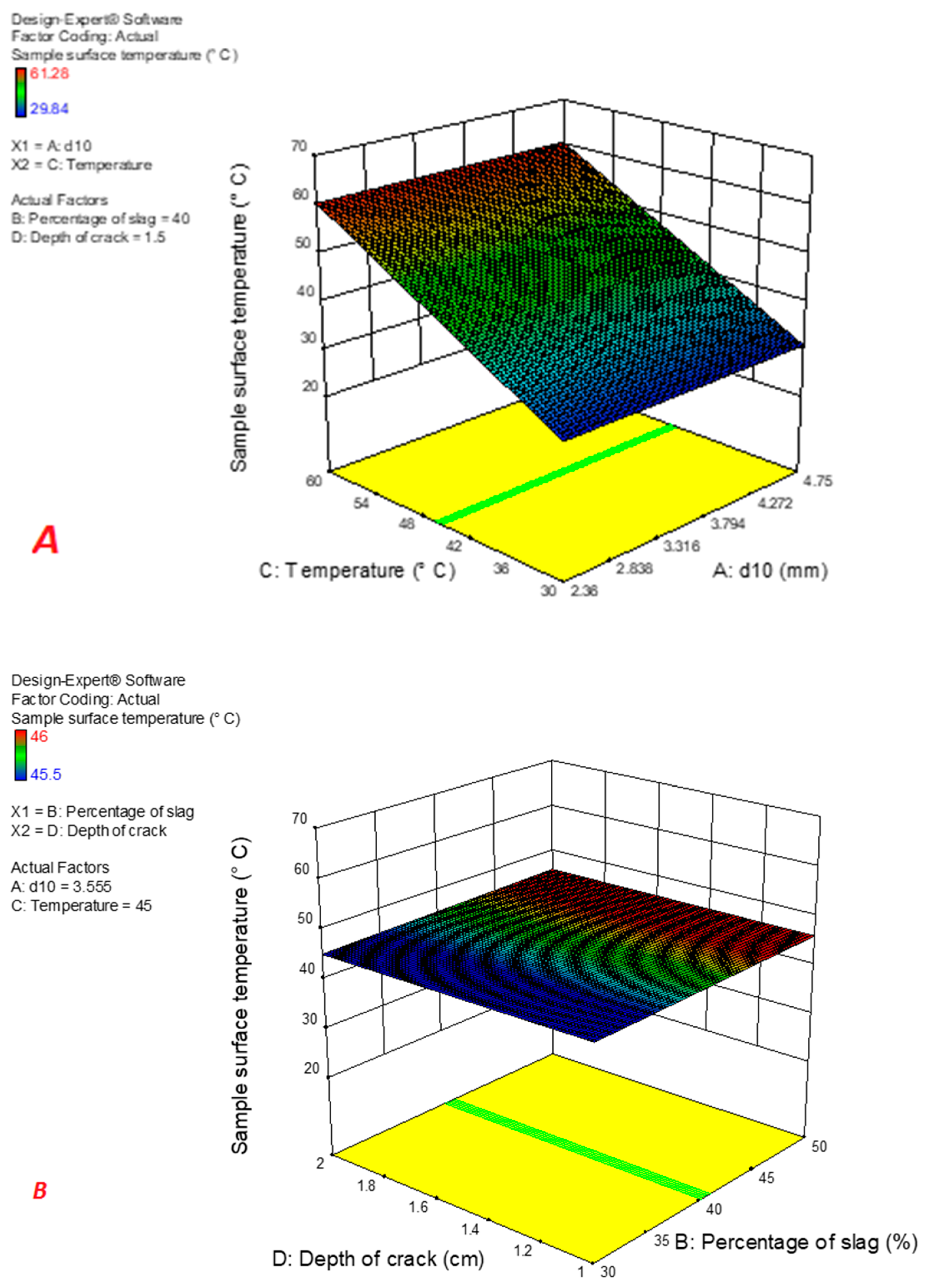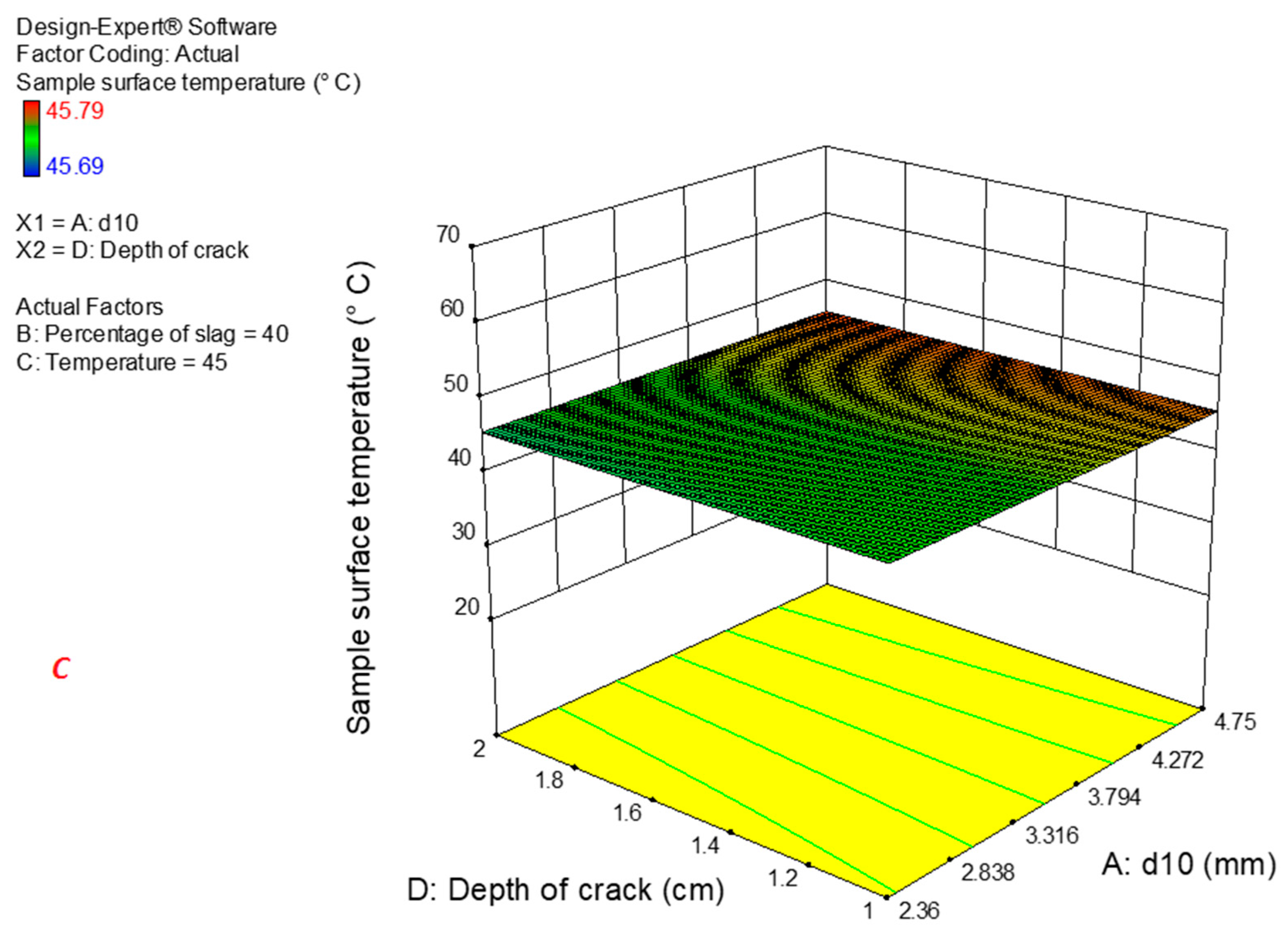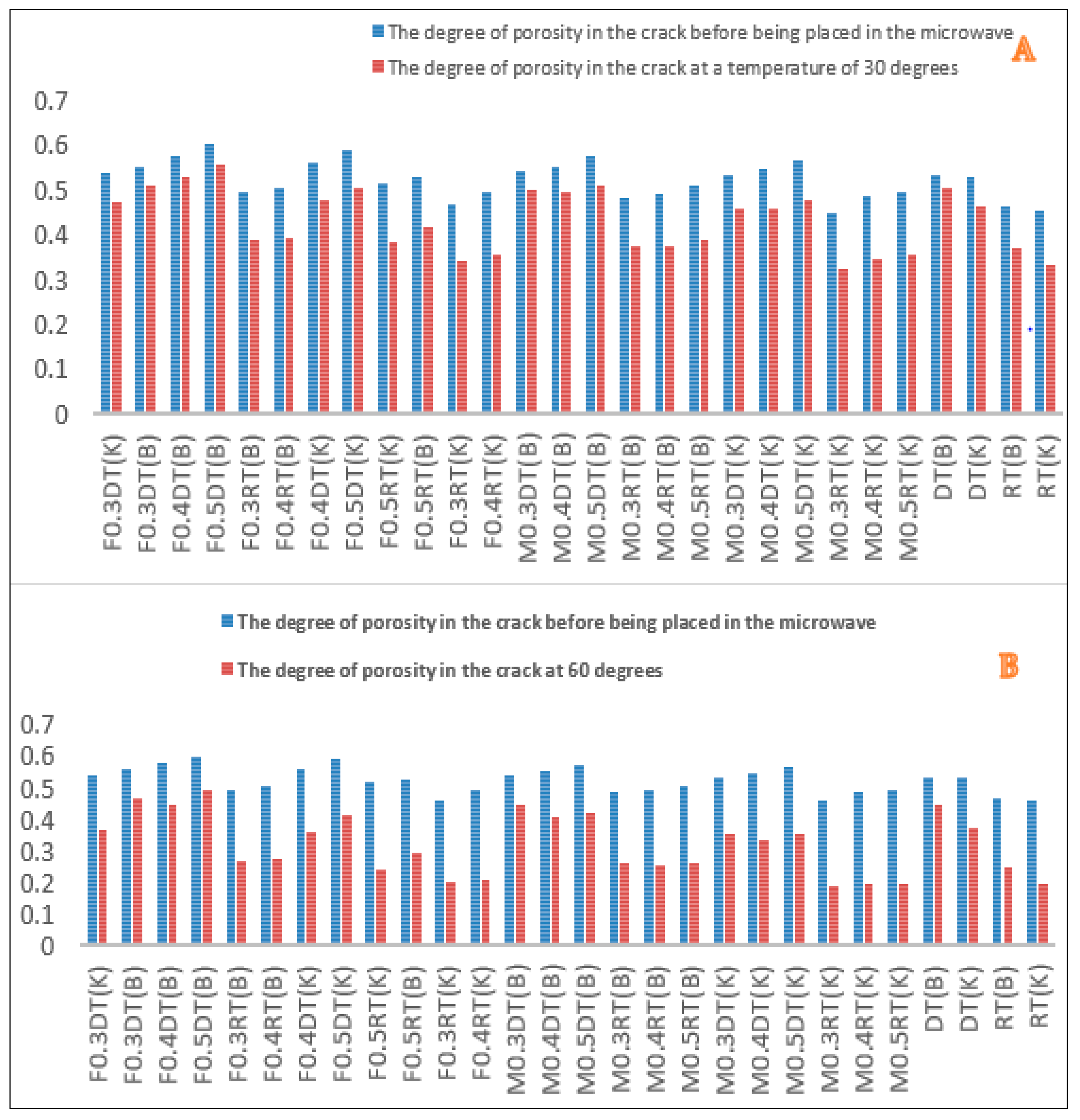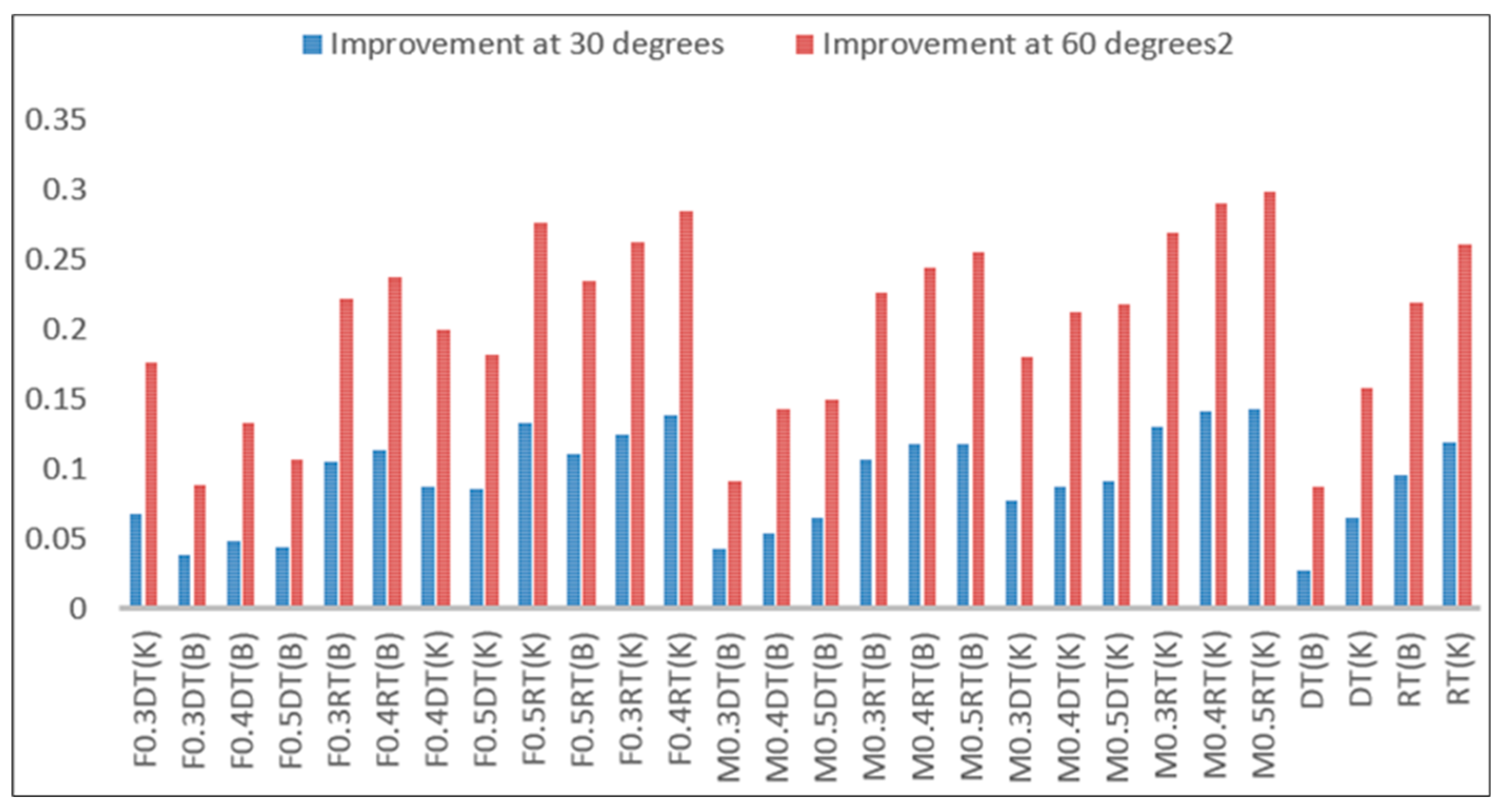1. Introduction
Road and pavement construction are undoubtedly considered the most extensive and essential development activities of any country [
1] as well as the first step towardprosperity and region development [
2]. Pavement building is an essential aspect of modern living. Cement is one of the most important, and commonly used materials for construction, road building, and cement-containing products emit a substantial quantity of greenhouse gas [
3]. Utilizing natural and raw resources causes environmental devastation and disturbance of natural ecosystems [
4].
In most countries of the world, flexible pavements always have the largest share in road construction; however, the application of this pavement is accompanied by high environmental hazards and disadvantages, such as instability against atmospheric factors, low resistance to heavy loads, and the need for constant repair and replacement [
5]. Many studies have been conducted in the application of concrete types. In the research results, researchers have investigated the effect of different molarities, the percentage of alkali to the binder, and the ratio of sodium silicate to sodium hydroxide on increasing fresh and mechanical properties of concrete. They have paid for geopolymer concrete. They showed that the structural performance of geopolymer concrete is higher than that of traditional concrete [
6]. The structural sector, such as columns, and the road construction sector, such as concrete pavement, rely heavily on concrete materials, their damage management, avoidance of cracking, and failure. Cracking is a common disease of concrete structures, and the use of microbial calcite deposition to the repair cracks is the focus of current research [
7]. In research for the effective control of crack repair, a comparison of the velocity distribution of elastic waves obtained from acoustic emission tomography analysis was used before and after repair. The results show the potential of the tomographic technique to be used to estimate the healing effect of the injection [
8]. Roller concrete pavement is dry (very low water-to-cement ratio) and low-cement concrete, with zero slump, and low hydration heat. The elastic coefficient of roller concrete pavement is less than that of ordinary concrete, which makes it perform better against cracking [
9]. Concrete pavement can be used to pave the floor of covered and open cisterns, wood, timber, and coal depots, etc.; cargo terminals, docks, and ports; roads for low-speed heavy vehicles and chained military vehicles, sloping roads, roads with low traffic, and speed; and urban and intercity streets, car parks, and internal traffic lanes of organizations and airports [
10,
11].
Pavement damage increases rapidly after the operation due to vehicle loads [
12]. Timely use of chip seals on old concrete slabs can improve the service level of the pavement and increase its life. In addition to repairing cracks, it also increases the abrasion resistance to improve the concrete surface and is used to make the road surface impermeable. Its use will strengthen the main layer of pavement. Numerous parameters of an asphalt pavement management database are utilized to characterize various road characteristics for various uses. This indicates that some characteristics of the pavement management database do not influence the choice to repair or upgrade the flexible pavement. In the road pavement management system, the proper repair and maintenance of cracks extend the pavement’s life by a quantitatively significant amount. This procedure prevents water penetration into the bottom layers, preserving the pavement’s carrying capacity and preventing its surface from deteriorating [
13]. One of the main failures in rigid pavements is cracks; hence, some studies have been performed on cracking concrete pavement, including RCC pavement and its repair [
14,
15]. Neville, for example, investigated the phenomenon of intrinsic repair of concrete and its cause in 1981. The researcher found that fine cracks in concrete are completely repaired under wet conditions due to hydration delays, the presence of unhydrated cement, and carbonation [
16]. Furthermore, several studies have been conducted on using different percentages of cement and additives, such as smelting iron slag and fly ash [
17,
18]. Research on the effect of fibers on the performance of RCC pavement revealed that the mortar–fiber interaction strongly affects the post-crack roller-compacted concrete pavement (RCCP) behavior. Therefore, post-crack area hardening in the load-crack mouth opening displacement (CMOD) curve is expected for high RCCP flexural strength at a high volumetric fraction of fibers [
19]. In recent decades, there has been a rise in the use of waste materials for asphalt, concrete, and building. The most significant emphasis has been paid to recycled concrete aggregates, recycled asphalt paving aggregates (RAP), crumb rubber, and steel slag aggregates from the electric arc furnace, which are extensively employed. According to previous research on the use of recycled materials in concrete, the tensile and compressive strengths of concrete are reduced due to the inclusion of these elements. However, little research has been conducted on using these materials in RCC for road pavement. There is still a great deal of research to be carried out on the properties of rolled concrete containing recycled materials [
20]. To study the effect of roller-compacted concrete (RCC) mixed waste materials with RAP or crumb rubber as a partial replacement of aggregates on mechanical properties, different samples with waste contents from 25 to 100% RAP and 5 to 25% crumb rubber were made in the laboratory. Then, these mixtures were tested to determine the composition efficiency of these wastes in concrete pavements. The results showed that the compressive and flexural strength of RCC specimens is improved by 5% rubber content. In addition, a combination of up to 10% rubber and 50% RAP could be cost-effective and useful to increase the pavement life by increasing the toughness and energy absorption of mixtures [
21]. In a study, the effect of shrinkage cracks on static load-bearing capacity and fatigue performance of RCC-reinforced pavements with recycled steel fibers were evaluated. It was found that these fine cracks penetrate up to a quarter of the slab thickness and reduce load-bearing capacity and pavement fatigue capacity by up to 50%. Even if the contraction initially causes minor cracks, they are significantly intensified due to the traffic load [
22]. The mechanical performance of RCC containing crumb rubber and nano-silica was studied by evaluating sixteen laboratory samples, including four different percentages of crumb rubber (0, 10, 20, and 30%) and nano-silica (0, 1, 2, and 3%). Results showed that increasing the crumb rubber increases the consistency, compressive strength, slip resistance, and tensile strength, and adding nano-silica improves the performance of RCC as well [
23].
The crack behavior of RCC mixtures containing modified asphalt pavement, and crumb rubber were analyzed by testing a set of 288 semicircular cracked bending (SCB) specimens with asymmetric three-point bending. Results revealed that the characteristics of the concrete mixture have a significant effect on the onset of RCC cracking [
11]. Research on the fracture properties of RCC reinforced with hybrid fibers manifested that the addition of fibers to the RCC mixture fails to affect the occurrence of possible torsion cracks during crack propagation. Results of the three-point bending test on shear beams showed a positive synergistic effect of short steel and macro polypropylene fibers on fracture toughness [
24].
Fresh and mechanical properties, as well as the durability of RCC containing regenerated asphalt pavement aggregates, were evaluated in the laboratory. The RCC mixture containing 50% coarse RAP and 50% fine aggregate was found to have high flexural strength. In addition, RCC mixtures containing recycled asphalt had sufficient abrasion resistance and were suitable for construction in areas with high concentrations of chloride and sulfate ions. Based on the results, higher ratios of fine-grained RAP were suitable for RCC application in sulfate environments [
25]. The effect of polypropylene fibers on fractur, and mechanical performance of RCC pavements was examined by performing a three-point bending test on grooved beams with different thicknesses. The fibers failed to improve the compressive and flexural strength, however, significantly improved the behavior of after cracking [
26].
The utilization of Response Surface Methodology (RSM) enables the establishment of links between various experimental factors and their corresponding responses through the integration and examination of multiple experimental designs. The tensile strength ratio of dry and saturated hot mix asphalt was evaluated by researchers using RSM to examine the impact of aggregate gradation and lime content. Using RSM, researchers identified the modifications in the rheological characteristics of asphalt binder at high temperatures due to varying amounts of Sasobit. Certain researchers employed RSM to investigate the influence of aggregate gradation, hydrated lime, and Sasobit content on the indirect tensile strength of warm mix asphalt. Additionally, other researchers identified the optimal conditions for incorporating plastic waste into asphalt mixing, utilizing RSM to enhance performance in terms of resistance to mixture failure under repetitive loading [
27]. In pavement detection, the Image Processing Method (IPM) has found extensive applications. To identify different types of pavement distress, various pavement inspection devices have been developed, such as digital cameras for detecting pavement cracks and laser scanning methods for identifying rutting or cracks, as demonstrated by researchers. Furthermore, Thermal Imaging Technology is currently utilized for controlling temperature segregation during asphalt paving. Additionally, image technology has been implemented for the extraction of pavement texture information for detecting potholes and joint faulting. Furthermore, owing to the progress and evolution of image detection technology, image systems have been integrated into vehicles to identify pavement failure and distress [
28]. Previous studies have demonstrated the successful utilization of RSM and IPM, indicating their capacity to delineate the complex behavior of pavement and its rehabilitation.
It was discovered that the surface condition of the road pavement is one of the safety factors. Previous studies have discussed the impact of surface deterioration on the safety of the pavement. According to the findings of the studies on the influence of repairing cracks on increasing friction and the safety of vehicle movement, it is crucial to repair cracks. Therefore, this experimental investigation aims to use appropriate materials and stone grading to the self-repair of pavement cracks. The roughness of the finished surface after execution has faced limitations and problems in applying this pavement. Thus, engineers improve the service quality of this pavement by applying a layer of asphalt coating. One of the most critical defects of asphalt-coated roller pavement is cracking; hence, the primary purpose of this study is to investigate the effects of gradation and aggregate material in filling RCC pavement cracks. In summary, the findings of this study may be used for the selection of slag materials and their proper grading, resulting in a reduction in the cost of making slag chip seal. In addition, these findings provide the foundation for large-scale laboratory manufacturing and real-world applications of this self-healing response.

